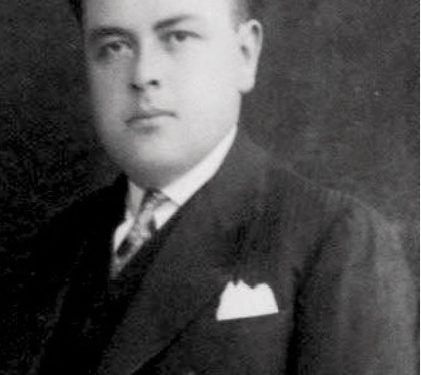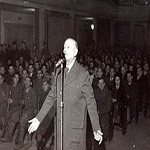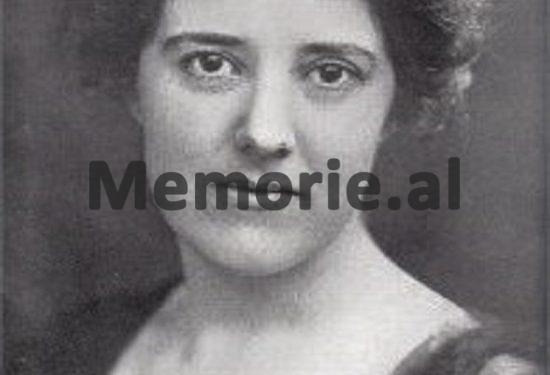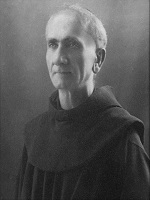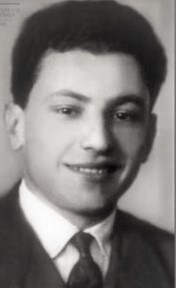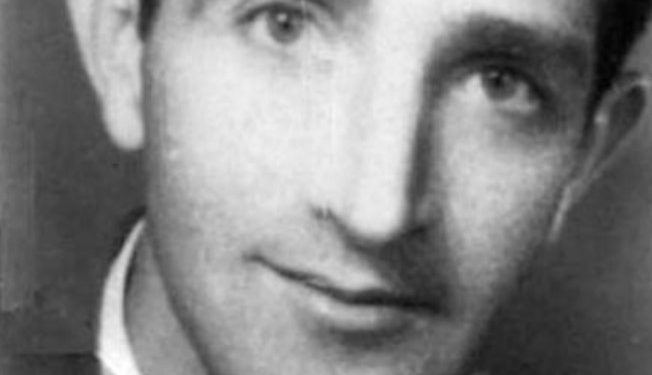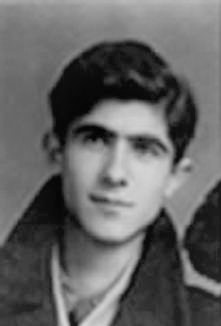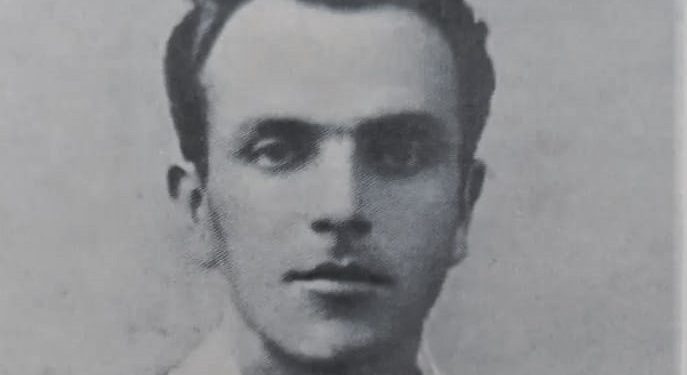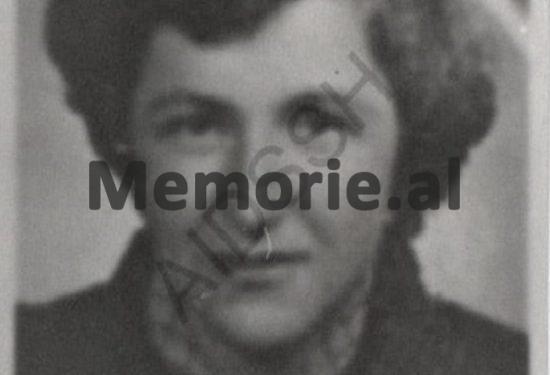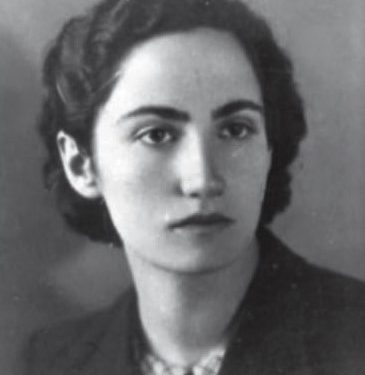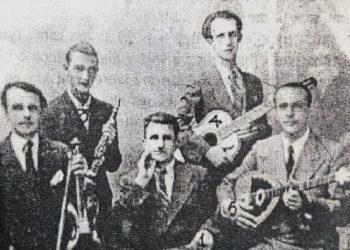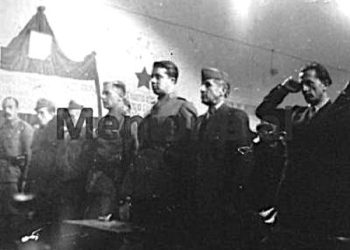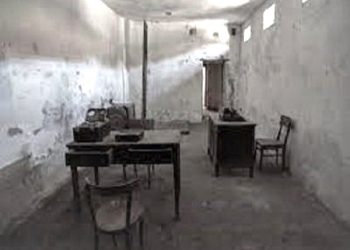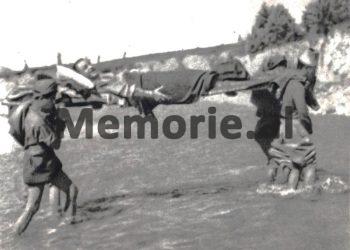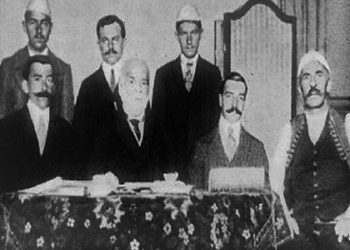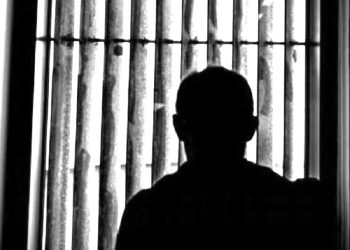The ninth part
Memorie.al/ publishes a study conducted by AIDSSH (Authority for the Information of Former State Security Documents), entitled; “DISAPPEARED – INSURANCE IN OWN WORDS”, 19 INSURANCE BRANCHES, 3299 LIFE, 1 HISTORY’, in which the ‘History of State Insurance’, which belongs to a time period from 1943 to 1991, is used. where 19 State Security branches are included, from the districts: Durrës, Kolonje, Burrel, Krujë, Lushnje, Dibër, Gramsh, Pogradec, Korçë, Tepelën, Elbasan, Lezhë, Saranda, Gjirokastër, Vlorë, Shkodër, Tropojë, Skrapar, Librazhd and Tirana.
Entry
INSURANCE IN OWN WORDS
“Those who think that communist regimes are the work of criminals only, overlook a fundamental truth: criminal regimes were not formed by criminals, but by convinced enthusiasts…”!
Milan Kundera, “The unbearable lightness of being”
Continues from last issue
Elbasan
Murder with cotton the history of the Security of Elbasan is the most unique of all the districts of the country. The harsh language, the intrigues, the traps, the executions during the war and after it have been completely cleaned, resulting in a “Security”, which is no longer the same as in other cities. And yet, Elbasan was part of Albania and the playwright Ethem Haxhiademi, was arrested in Elbasan, and would die in Burrel, being even today without a grave.
“He was hit and received the punishment he deserved…”, is almost the maximum I come across in History. The term “criminal”, ubiquitous in other districts, is here replaced by “kulak”. At State Security Elbasan, they rarely come out killed, rarely shot on the streets or in the mountains, rarely come out the methods of processing. However, despite the cotton language, there were arrests on the other side, which are not always mentioned. Instead of the terms: shooting, liquidation, annihilation or murder, which is found in other historians, Elbasan uses only one verb, that too in the past tense,: was hit (!) Even in cases where a fugitive is mentioned, such as N. H., ex- cooperative chairman of Rrajca, the processing methods are not shown, it is simply noted that he was convicted of treason against the homeland. But what is not said does not mean that it did not happen, and the other side of the story shows what history hides.
Burrell Prison Interpreter
“Winter night… January 25, 1947, Tuesday. We were all gathered around Votra in the fire room…! Baba was correcting the writings of a class of the ‘Normal’ of Elbasan…! Taking advantage of the collapsed wall of the courtyard, armed people entered our house after a while…! They presented themselves as people from the local government, because they had allegedly come for control, for prohibited items for the time being…! I saw…later the father, coming down the stairs with his hands tied…! He was accused of conspiracy to overthrow the government, of collaboration with the Anglo-Americans”. The son, Emini, remembers his father’s arrest with these words.
After that night, the name of Ethem Haxhiadem (1902-1965) would disappear for more than 4 decades, from 1947 until after 1990. In the same time, his plays, tragedies, poems, translations and studies would be silent. Before that night, he had the whole world in his hands. With high school completed in Lecce (Italy), he would follow studies in Innsbruck (Austria) and Political Science in Berlin and Vienna. Former prefect of Lushnja, director in the Ministry of the Interior, member of the new Institute of Albanian Studies, after the war he became a member of the League of Writers and chairman of its branch for Elbasan. In 1946, he was a teacher of the Albanian language at the ‘Normal’ School in Elbasan, until he was arrested and sentenced to death. His library and manuscripts were confiscated, while after the intervention of Aleksandr Xhuvan and Omer Nishan, the death sentence was returned to life imprisonment. He died on March 17, 1965, after having worked for many years as a translator in the Burrel prison.
The sad surrender of Lef Nos
“XH. N., was recruited by the “Directorate of People’s Protection” and treacherously took Lef Nosi into the hands of the forces that arrested him on August 7, 1945. In the study of the historian Edmond Malaj, about the persecution of Lef Nos, all the places where he hid from his friends so as not to fall into the hands of the Security are noted; from Shkodra, in the Dukagjini Highlands, in Tirana to several families and to Xhemal Farka’s mill, and then to Elbasan, where he took refuge in forests, apartments and even an alcohol factory.
The Military Court of Tirana judged together with Father Anton Harap “accused as war criminals and enemies of the people… in their capacity as members of the Regency during the Nazi occupation, they collaborated and served this occupier to the detriment of high interests of the Motherland and are responsible for all crimes, destruction and material damage committed in our country”.
His friend, the anthropologist Margaret Hasluck, sent a letter to Enver Hoxha, where she was ready to testify before any Albanian court, for the innocence of Lef Nos, but on February 12, 1946, the Military Court of Tirana sentenced him to death by firing squad. He was executed on the Hill of the Priest (or, according to another version, on the Hill of the Bektashian Grandmother), along with Malik Bushat and Father Anton Harapin.
Participant of the Congress of Manastir, one of the delegates of Elbasan in the Assembly of Vlora, signatory of the Declaration of Independence of Albania, Minister of Posts and Telegraphs (December 4, 1912-February 21, 1914), Chairman of the National Assembly (1943), Member of the Regency (1943-1944), publisher, archivist, philologist, folklorist, ethnographer, numismatist, archaeologist and politician. One of the most versatile figures in the country, you were born in the ‘Kala’ neighborhood of Elbasan, in one of the biggest families in the city…!
Regarding his execution, Adelina Kosturi remembered that: “Right after the shooting, my brother-in-law, Jorgaq Kosturi, took two workers, covered them with earth, because they were buried very shallowly, and placed a jar at Lefi’s feet, to identify him later. This grave has not been found yet”!
Fan Noli’s secretary dies in misery
In the history of Security in Elbasan, he is mentioned as an element that opposed the Party’s line, but without giving the consequences of this opposition. “Qamil Çelirama, who had previously held positions of state importance and who was known as an old communist and a participant in the war in France, began to pour bile against the Party’s line…”!
A friend of Lef Nosi, Hilë Mosi, Dervish Hima, Mithat Frashëri, he had worked in the government cabinet of Sulejman Delvina and Iljaz Vrioni and in the ministry of Xhafer Ypi. The murder of his friend, Avni Rustemi, kept him in Tirana, when he then became Fan Noli’s secretary, working with Haki Stërmilli. After the fall of the government in 1924, he emigrated.
In Bari he took refuge with Bahri Omari, while in France he would become a member of the Communist Party. He is in Paris, when the Albanian delegation goes to the Peace Conference, and there he meets Enver Hoxha and Hysni Kapo. With the intervention of Ymer Dishnica, he returns to Albania and is appointed Chairman of the Albanian Red Cross. On Hoxha’s 60th anniversary, a visit is made to him from Tirana, where he is asked to witness Enver Hoxha’s revolutionary activity in Paris as a student and he answers that; “he did not recognize him as such”. After this answer, the pension is expected. Those who knew him, such as Bukurosh Dylgjeri, confess that his retirement years were his years of isolation, while State Security agents followed and provoked him everywhere. “In the years 1974 – 1975, Qamil Çeliram was called an “enemy of the people” and as such he spent 14 years in isolation, under house arrest”, adds Dylgjeri, confessing that he died in complete misery.
TIRANA
Vangjel Lezho, the impossible journey to Moscow
Former student of “Normal” in Elbasan, graduated in journalism in Moscow in 1959, Vangjeli, father and husband, started working as a culture journalist at Radio Tirana. When relations between Albania and the Soviet Union were falling apart, he saw a light somewhere in the distance. On a scorching Sunday in July of 1963, Fadil Kokomani and Vangjel Lezho were absent from a visit that the journalists of Radio Tirana made to the home of a colleague who was getting married. The next day, word spread on the radio that Lezho had been arrested in an attempt to escape from Pogradec. That day, Kokomani looked surprised. A few days later, he too would be in the cell.
The Lezho investigation must have been torture. He had left a room at home in Tirana and tried to escape, to join his Russian wife and daughter. “In March 1962, Robert Vullkani was taken into preliminary processing. In the month of April, according to the opinion given by Trifoni, together with Vangjeli and Fadil, they write texts with hostile content and on April 28… They display and spread them in the streets of the city”, it is written in the Security History.
In his 30s, he was sentenced to prison in Spaç, together with his friend Kokomani. They were accused of being in contact with the Soviet officer Valentin Zhej. 13 years later, he is more revolted than he was outside of prison. On July 9, 1978, Lezho, Kokomani and their friend in prison, Xelal Koprencka, send letters to the senior leaders of the APS, Hysni Kapo and Ramiz Ali, where they severely criticize Enver Hoxha. “Enver’s empire is kept alive by the army of spies…! This ‘Olympus’ of ours has filled Albania with prisons, which surpass those of fascism…”! After the letters arrived in Tirana, Lezhon and Kokomani are awaiting re-conviction. If they escaped death the first time, they didn’t make it the second time. On May 18, 1979, he was sentenced to death by firing squad for “creating and participating in a counter-revolutionary organization.” It was executed on May 28 of the same year. His remains have not yet been found!
“It’s been 18 years since the Albanian leadership, constantly leading the people, always with a bent back, to the most shameful precipice that history has seen, attacks without stopping, like owls in the dark, the country and the great people of October, with the most arrows sick and poisoned”!
From July 1978 letter
Fadil Kokomani, the journalist who shot the “gods”!
“In the first, large photo, there were the three of them, somewhere in a forest, at night, in nature, tied with a rope, looking at the camera of the photographer who was photographing them in the moment before shooting. So they were alive. And surprisingly it was what attracted me the most…! That caught my eye…! As if they were alive and saw me and I saw them…! Then the next picture, big again, was all three, but now lying down, dead. While in the three small photos, each one was on his own, with the bullet on his forehead…”!
Fadil Kokomani, Vangjel Lezho and Xhelal Koprencka, were executed, when Fatos Lubonja, co-sufferer in Spaç, under pressure, their images were put in front of him. It was the year 1979. The story that preceded those photographs began in 1963. The first to fall into the handcuffs is Vangjel Lezho. A few weeks later, on a Tuesday evening in August, Fadil Kokomani was leaving Radio Tirana. It was in his 30s, when his life was closed between the walls.
Having studied at the University of Leningrad (St. Petersburg), he wrote stories, reportages and literary sketches, but had not accepted the invitation to join the party. The accusation against him is; “as the leader of a group that had distributed tracts and wanted to assassinate the prime minister”. The historian of the Tirana Security claims that Trifon Xhagjika, Fadil Kokomani and Vangjel Lezho wanted to kill the Minister of the Interior and some employees of the Security, to which the latter adds that; “Fadili had found a bayonet, with which they tested how a person can be killed”!
He is sentenced to death and his life is spared by decree of the Presidium of the People’s Assembly. From Spaçi, where he served the sentence together with Vangjel Lezhon, in 1978, he sent a letter to the Central Committee of the APS and was sentenced to 10 years in prison.
“You created a new religion of the gods of Tirana, you created a new God in the person of Enver Hoxha, who is feared and feared by all, as he has become the God of the family, of separations and marriages, of stocks and exhausting choirs, of a morsel of bread and – what is the most shocking – he is the primary and permanent capitalist and employer of this Albanian land,” wrote Kokomani and Lezho.
While he was serving his sentence in the Spaçi camp, on February 23, 1979 he was arrested again and, on May 18 of the same year, he was sentenced to death by firing squad “for creating and participating in a counter-revolutionary organization” and “for agitation and propaganda”. He was executed on May 29, 1979, together with Vangjel Lezho and Xelal Koprencka. The journalist and writer is still without a grave, despite the efforts to search for his remains by his nephew, the former Minister of the Interior, Spartak Poçi (1999).
Part of the letter from the prison of Fadil Kokoman and Vangjel Lezho
“In a state where the general and particular life is subject to the thought and political course of an eternal suite, no doubt this state is invaded by an abyss of immorality! In Socialist Albania, the child, as soon as it comes out of the mother’s womb, is given a rifle and they do this only with the humanitarian goal that he, the child, when he grows up, kills himself”!
Searching for bones
– The confession of Kokoman’s nephew, Spartak Poçi (Minister of the Interior in 1999)
“Together with the officer, we went to the indicated place. It was located next to a wretched military barracks, which, although without any apparent function, was guarded by a soldier. I immediately raised a digging team and we started that day, but by dusk we found nothing. They continued the next day, the day after tomorrow….!
Narrative of the firing platoon officer
The officer of the shooting platoon told former minister Spartak Poçi, Kokoman’s nephew, that the nightmare of the shooting night haunted him all his life. “I felt too weak to react…! When the car started, it was Fadili who asked where we were going…! Once we stopped in a narrow and dark path…! Next to it was the pit. It was a scene that belied the date. We sat them on their knees, facing the pit. They were shot immediately, almost simultaneously, with one bullet in the head, from behind, at close range…! I often fall asleep and remember all three. I have experienced no greater horror than that black night. I suffered an indelible friend”. Fadil Kokomani, Vangjel Lezho, Xelal Koprencka were executed.
Xelal Koprencka, 5 convictions, one with death
The most famous image of Xelal Koprencka is that of a young boy. It almost looks like a child. You smile with twinkling eyes. Behind that bright portrait is the story of a boy who was sentenced five times by the communist regime. It is the story of a boy who one night, with his hands tied, was taken out of his cell and taken to be shot, on a barren slope in the outskirts of Tirana. And in the end is the story of a boy who after that night, the fate of his body is not even known.
He came from a large family from Skrapari. His grandfather, who had the same name, had been a signer of Independence and had been mysteriously murdered,. The first sentence was given in 1967, when he was 35 years old. After prison sentences in Tirana, Saranda and Ballshi and working as a plumber in Shkodër, he arrived in Spaç in 1977. In prison he met journalists Vangjel Lezho and Fadil Kokomani. They were almost the same age. When the two journalists send a letter to Ramiz Ali and Hysni Kapo, openly denouncing the communist regime, Koprencka also sends a similar letter, with the same accusations, about an oppressive system maintained by an army of spies. His letter has not been found, just as the photo of the dead body, which was supposed to be shown to the convicts as a form of pressure, has not been archived, but after these letters, the three are arrested again and the trial awaits them. The first charge was agitation and propaganda.
The People’s Court of Mirdita District declared him guilty and sentenced him (combining the previous sentences) with 25 years of imprisonment. But a new accusation awaits him, as well as his friends. He was arrested again on February 23, 1979, with the claim that he had created an organization, as “a raging enemy of the state of the dictatorship of the proletariat and the socialist construction of the country”. He does not accept it. In front of the investigator Dhimitër Beshiri, he called it “just a fantasy”.
While he was in the cell in Tirana, they put him next to an associate of the Sigurimi to break him down. The result is known. With decision no. 3, dated 9.5.1979, the Supreme Court declared the defendant guilty, for; “participation in the anti-socialist organization” and agitation and propaganda according to articles 55 and 57 of the Criminal Code, sentencing Kokomani, Lezhon and Xhelal Koprencka to death by firing squad.
Abduction and killing of Galip Hatib
Accused of “entering the espionage service of American imperialism”, 26-year-old Dibran Galip Hatibi, newly married, on September 25, 1946, was arrested by the State Security forces. The evidence speaks of an arrest that takes the form of a secret kidnapping, in front of the University of Tirana building. “In 1946, by order of Nest, I illegally arrested Galip Hatib… as an agent of the Americans. He was interrogated by Nesti and Thoma Karamello..! I know that often, Nesti and Thomai, have beaten Galip badly and treated him very badly. He was killed illegally in July-August 1948, with a special trial, made on the orders of Vaska by Angji Faber and Skënder Kosova”, asserted the senior officer of the Security, Vango Mitrojorgji in his self-criticism.
Kept isolated for a long time in the basement of the State Security Section (in Selvia), he was never questioned, until he was executed, according to some testimonies, somewhere near the Kinostudio area, after he had been reduced to skin and bones. .
During his own process, Koçi Xoxe already charged, claimed that; “For Galip Hatib, Vaska (Koleci) told me that he was put in a miserable state and thus, even by the decision of the Commander (Enver Hoxha), he was executed with a formal trial”. His subordinate, Vango Mitrojorgji, also claimed that: “regarding the use of torture, when resistance was encountered, torture was used more until the arrested person died or told”. While in the trial against Kadri Hazbiu and Feçor Shehu, the indictment mentions that; “From the evidence and facts gathered by the investigation bodies, many cases of such murders, committed without trial, by order of the traitors Mehmet Shehu, Kadri Hazbiu, Mihallaq Ziçishti and Llambi Peçini, have become concrete. The murders committed in Pukë, Rrëshen, Krujë, Burrel, Berat, etc. are mentioned here, such as the murder without trial and then the burning in the oven by Mihallaq Zicishti, of Galip Hatib, who was arrested as a spy for the Americans.
The testimonies of the persons responsible, include some guilty in his execution, breaking the communist laws themselves, his fate remains unclear, as the place where his remains rest was never learned!
After the murder of Galip, the wife Assemble Hatibi, knew the ordeal of suffering together with the child, Durim. In addition to the resentment she had against the regime that killed her husband, another accusation against her was that she has reinforced the words about Enver Hoxha’s bad moral character. The assembly would be arrested in October 1978 to be released in November 1982.
Besides her, her son was also persecuted. Although talented in football, he was left to work in the geological enterprise. “He is very correct, very closed, but a volcano boils in his chest. It was advised”, State Security writes about him.
Insurance accepts manipulation
The senior officer of the Security, Vango Mitrojorgji, taken as a defendant after the arrest of Koçi Xoxes, in a self-criticism he makes, reveals the manner of Andrea Zisi’s death. Andrea was an early communist, founder of the “Fire Group”, a communist group established in Athens and from the first years, in conflict with the communists, who would take power. In the memoirs of Koço Tashko, Zisi is mentioned for his connections with the Greek communists and also as a saboteur who collaborated with Mustafa Kruja. The Security Officer, Vango Mitrojorgji, revealed how he died. “I know that when I was in D.P.M., Vaska ordered to execute a certain Andrea Zisi, who was executed by Captain Kapo Kapaj. They have masked this, because he allegedly ran away from the car”.
The punishment of three women
Liri Gega, Dhora Leka and Selfixhe Broja, (Ciu), were convicted and accused of being related to the Yugoslav discoveries. Their lives were completely different, the destinies and decisions they took until the end, as well, as is the memory of them even today.
Selfixhe Ciu was a friend of Musine Kokalari, journalist and writer, who had published her first writings in 1935. After her studies in Florence, she returned and reconnected with communist groups and was exiled several times with her husband. “We who put a brick in this building that destroyed our lives, the lives of this people, probably deserved those sufferings, that ordeal”, the daughter confessed, Selfixe and Xhemal Broja told her.
Dhora Leka was a composer associated with the National Liberation War and creator of a number of partisan songs. While Liri Gega, former member of the Political Bureau, in the war very close to Enver Hoxha, was the wife of Major General Dali Ndreu, former Commander of the First Corps during the War. Both Liri Gega and Dali Ndreu were sentenced to death, after being accused of being “agents of Tito’s Yugoslavia” and executed.
In the history of Tirana Security there is a document that unites the three. “All cadres of the Yugoslav Intelligence were put in motion and put in contact with a part of their old agency and young recruits, such as Petro Bullati, Dali Ndreu, Liri Gega, Dhora Leka, Zija Dibra, etc. Through Dhora Leka, they connected with other enemies of the Party such as Bedri Spahiu, Tuk Jakova, etc…! The persons who were fully proven to have been put in the service of the Yugoslavs were arrested, such as; Dali Ndreu, Liri Gega, Petro Bulloti, Zija Dibra, Dhora Leka, etc. Measures were taken to intern and expel from Tirana a number of dangerous elements involved with the Yugoslav spies, such as; Pëllumb Dishnica, Nesti Zoto, Selfixhe and Xhemal Broja, etc., a total of 25 families.
“From the study done by the cooperation groups, the commissions, it was found that about 300 people arrested were enemies or suspected of hostile activities. Among them, in addition to the leaders of the reaction of war criminals, were General Mirdasi, Beqir Valteri, Estref Frashëri, Terenc Toçi, Fejzi Alizoti, whose activity was known”.
Accusations as agents
The Americans “recruited the old agents, like; Llazar Papapostoli, Shaban Balla, Kolë Kuqali, degenerate and bourgeois intellectuals, like; Gjergj Kokoshi, Abdyl Sharra, Kujtim Beqiri, Beqir Çela, Enver Sazani, Sulo Klosi, Selaudin Toto, etc., people of inverted classes, like; Shefqet Beja, Bejat, Toptanasit, etc. Clergy Sheh Ali Pazari, Dom Shtjefën Kurti, Andon Dukagjini, Meshkalla, etc.”!
“A pronounced hostile activity was carried out by the clergy. Under the pretext of protecting religion, they propagated against popular power. Tirana madrasa and mosques turned into the main centers of reactionary activity led by the former chairman of the committee of the ‘National Front’, of the Muslim community, Afez Ismet Dibra e Sheh Ali Pazari.”/Memorie.al




